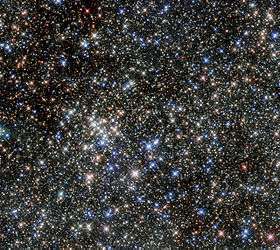Pistol Star
The Pistol Star is a blue hypergiant star; one of the most luminous known in the Milky Way. It is one of many massive young stars in the Quintuplet cluster in the Galactic Center region. The star owes its name to the shape of the Pistol Nebula, which it illuminates. It is located approximately 25,000 light years from Earth in the direction of Sagittarius. It would be visible to the naked eye as a fourth magnitude star if it were not for the interstellar dust that completely hides it from view in visible light.
| Observation data Epoch J2000 Equinox J2000 | |
|---|---|
| Constellation | Sagittarius |
| Right ascension | 17h 46m 15.3s[1] |
| Declination | −28° 50′ 04″[1] |
| Apparent magnitude (V) | >28[2] |
| Characteristics | |
| Spectral type | LBV[2] |
| Apparent magnitude (J) | 11.828[3] |
| Apparent magnitude (H) | 8.920[1] |
| Apparent magnitude (K) | 7.291[1] |
| Variable type | cLBV[4] |
| Astrometry | |
| Radial velocity (Rv) | +130[2] km/s |
| Distance | 8,000[5] pc |
| Details | |
| Mass | 27.5[5] M☉ |
| Radius | 306[5] R☉ |
| Luminosity | 1,600,000[5] L☉ |
| Temperature | 11,800[5] K |
| Metallicity [Fe/H] | 0.1[6] dex |
| Age | ~4×106[7] years |
| Other designations | |
| Database references | |
| SIMBAD | data |
Properties
.jpg)
The Pistol Star was discovered using the Hubble Space Telescope in the early 1990s by Don Figer, an astronomer at UCLA.
The star is thought to have ejected almost 10 solar masses of material in giant outbursts perhaps 4,000 to 6,000 years ago (as observed from Earth). Its stellar wind is over 10 billion times stronger than the Sun's. Its exact age and future are not known, but it is expected to end in a brilliant supernova or hypernova in 1 to 3 million years. The mass is equally uncertain, thought to have been over 100 times the Sun when initially formed but now considerably less due to extreme mass loss. Modelling the star itself to match its spectrum gives a mass of 27.5 M☉,[5] while matching its current properties to an evolutionary model gives a much higher mass (86–92 M☉).[8]
Later studies have reduced its estimated luminosity making it a candidate luminous blue variable about one-third as luminous as the binary star system Eta Carinae.[9] Even so, it radiates about as much energy in 20 seconds as the Sun does in a year.
A close point source has been discovered hidden in the surrounding nebulosity, but there has been no confirmation of this being a star or whether it is physically associated.[10]

See also
References
- Cutri, R. M.; Skrutskie, M. F.; Van Dyk, S.; Beichman, C. A.; Carpenter, J. M.; Chester, T.; Cambresy, L.; Evans, T.; Fowler, J.; Gizis, J.; Howard, E.; Huchra, J.; Jarrett, T.; Kopan, E. L.; Kirkpatrick, J. D.; Light, R. M.; Marsh, K. A.; McCallon, H.; Schneider, S.; Stiening, R.; Sykes, M.; Weinberg, M.; Wheaton, W. A.; Wheelock, S.; Zacarias, N. (2003). "VizieR Online Data Catalog: 2MASS All-Sky Catalog of Point Sources (Cutri+ 2003)". VizieR On-line Data Catalog: II/246. Originally Published in: 2003yCat.2246....0C. 2246: 0. Bibcode:2003yCat.2246....0C.
- Figer, Donald F.; Morris, Mark; Geballe, T. R.; Rich, R. Michael; Serabyn, Eugene; McLean, Ian S.; Puetter, R. C.; Yahil, Amos (1999). "High-Resolution Infrared Imaging and Spectroscopy of the Pistol Nebula: Evidence for Ejection". The Astrophysical Journal. 525 (2): 759. arXiv:astro-ph/9906479. Bibcode:1999ApJ...525..759F. doi:10.1086/307927. S2CID 19404691.
- Cutri, R. M.; Skrutskie, M. F.; van Dyk, S.; Beichman, C. A.; Carpenter, J. M.; Chester, T.; Cambresy, L.; Evans, T.; Fowler, J.; Gizis, J.; Howard, E.; Huchra, J.; Jarrett, T.; Kopan, E. L.; Kirkpatrick, J. D.; Light, R. M.; Marsh, K. A.; McCallon, H.; Schneider, S.; Stiening, R.; Sykes, M.; Weinberg, M.; Wheaton, W. A.; Wheelock, S.; Zacarias, N. (2003). "VizieR Online Data Catalog: 2MASS All-Sky Catalog of Point Sources (Cutri+ 2003)". VizieR On-line Data Catalog: II/246. Originally Published in: 2003yCat.2246....0C. 2246. Bibcode:2003yCat.2246....0C.
- Nazé, Y.; Rauw, G.; Hutsemékers, D. (2012). "The first X-ray survey of Galactic luminous blue variables". Astronomy & Astrophysics. 538: A47. arXiv:1111.6375. Bibcode:2012A&A...538A..47N. doi:10.1051/0004-6361/201118040. S2CID 43688343.
- Najarro, F.; Figer, D. F.; Hillier, D. J.; Geballe, T. R.; Kudritzki, R. P. (2009). "Metallicity in the Galactic Center: The Quintuplet Cluster". The Astrophysical Journal. 691 (2): 1816–1827. arXiv:0809.3185. Bibcode:2009ApJ...691.1816N. doi:10.1088/0004-637X/691/2/1816. S2CID 15473563.
- Bono, G.; Matsunaga, N.; Inno, L.; Lagioia, E. P.; Genovali, K. (2013). "Stellar Populations in the Galactic Center". Cosmic Rays in Star-Forming Environments. Astrophysics and Space Science Proceedings. 34: 115–132. arXiv:1304.6211. Bibcode:2013ASSP...34..115B. doi:10.1007/978-3-642-35410-6_9. ISBN 978-3-642-35409-0. S2CID 118491792.
- Liermann, A.; Hamann, W.-R.; Oskinova, L. M. (2012). "The Quintuplet cluster. III. Hertzsprung-Russell diagram and cluster age". Astronomy & Astrophysics. 540: A14. arXiv:1203.2435. Bibcode:2012A&A...540A..14L. doi:10.1051/0004-6361/201117534. S2CID 118741449.
- Yungelson, L. R.; Van Den Heuvel, E. P. J.; Vink, Jorick S.; Portegies Zwart, S. F.; De Koter, A. (2008). "On the evolution and fate of super-massive stars". Astronomy and Astrophysics. 477 (1): 223–237. arXiv:0710.1181. Bibcode:2008A&A...477..223Y. doi:10.1051/0004-6361:20078345. S2CID 18269577.
- Humphreys, R.; Stanek, K. (2005). "The Fate of the Most Massive Stars". The Fate of the Most Massive Stars. 332. Bibcode:2005ASPC..332.....H.
- Martayan, Christophe; Blomme, Ronny; Le Bouquin, Jean-Baptiste; Merand, Anthony; Montagnier, Guillaume; Selman, Fernando; Girard, Julien; Fox, Andrew; Baade, Dietrich; Frémat, Yves; Lobel, Alex; Martins, Fabrice; Patru, Fabien; Rivinius, Thomas; Sana, Hugues; Štefl, Stanislas; Zorec, Juan; Semaan, Thierry (2011). "High-angular resolution observations of the Pistol star". Active OB Stars: Structure. 272: 616–617. arXiv:1010.3342. Bibcode:2011IAUS..272..616M. doi:10.1017/S1743921311011574. S2CID 117073391.
External links
| Wikimedia Commons has media related to Pistol Star. |
